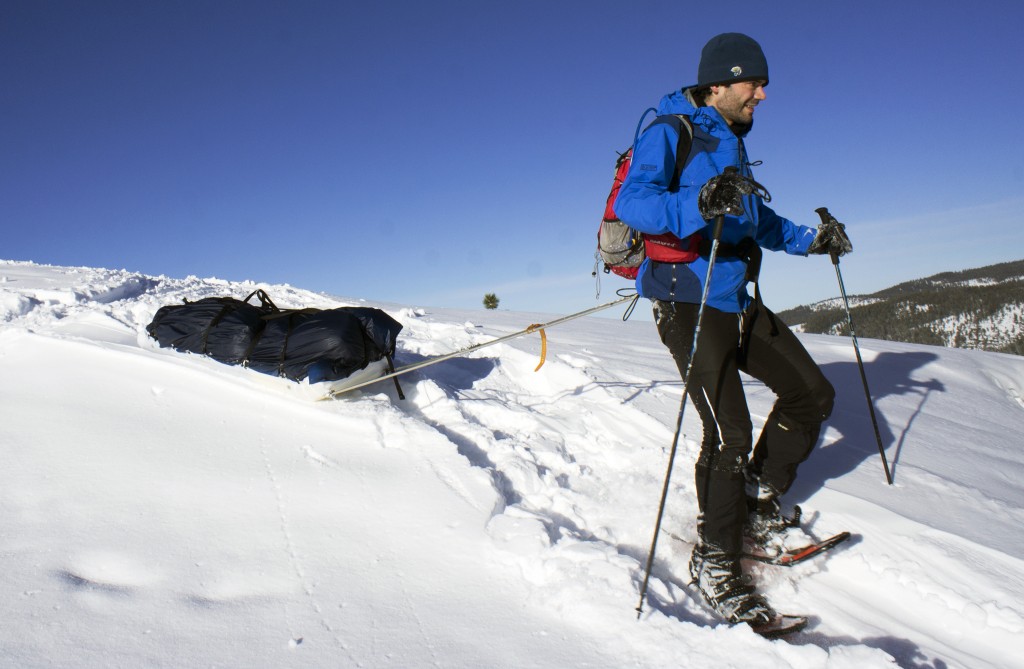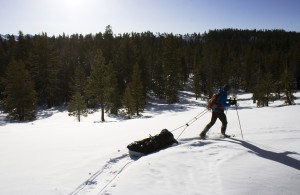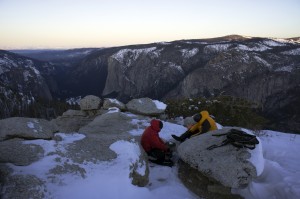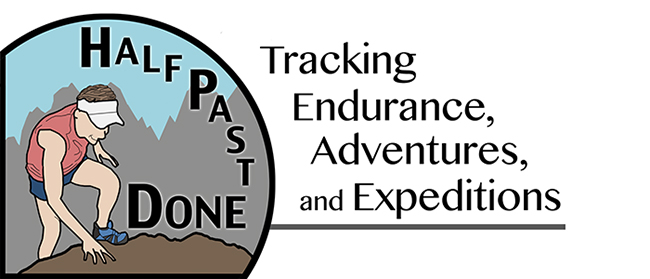
Beat Jegerlehner tests his sled on Sentinel Dome in Yosemite National Park.
Editor’s note: Beat Jegerlehner is preparing to compete in the Iditarod Trail Invitational, a thousand-mile, human-powered trek across frozen Alaska on the famed Iditarod Trail. The race begins Feb. 24 in Knik, Alaska, and Beat will be competing on foot. This post is the second in a series covering his preparation and participation in the race. View the first post here.
When Beat Jegerlehner goes for training runs on the Glacier Point ski trail in Yosemite National Park, he often gets inquisitive looks and comments from other trail users. Because while others glide down the trail on skis with lightweight backpacks, Beat is marching along the rough edge while dragging a six-foot sled loaded with what looks like, as he calls it, “a dead body builder.”

Sled build from Ultra High Molecular Weight Polyethylene.
The long sled and its many supplies are a necessary component of his thousand-mile trek to Nome, Alaska, which begins Feb. 24. In order to acquire a design that fits his exact needs, he constructed his own sled, pole, and harness system from lightweight materials. The harness is made from nylon webbing attached to a thirty-liter Raidlight backpack. The poles are constructed form hollow aluminum tubbing, and the sled is made from a single sheet of Ultra High Molecular Weight Polyethylene — as Beat calls it “The material of Greek Gods. Thor’s hammer’s handle is made of it.” UHMW Polyethylene is both strong, light, and low friction — allowing for better glide over even rough snow and exposed ground. He added a couple of plastic runners to the bottom for better tracking on smooth surfaces.
The sled is six feet in length to allow him to sleep inside when needed — all he has to do is remove his duffel bag and unroll his sleeping bag bundle for a quick nap. And although it looks bulky enough to hold the remains of a deceased body builder, the components of the sled are much lighter — somewhere in the range of 40 to 45 pounds including food weight. The six-foot length allows him to loosely distribute his gear for easy access without fussing with compression bags.
The following is a list of Beat’s planned gear for survival and athletic performance in temperatures that will likely range from 40 above to 50 below zero, precipitation that can range from rain to ice pellets to white-out blizzards, wind speeds that will top sixty miles and hour, and trail conditions that can range from powder snow to glare ice to exposed dirt and frozen tussocks:
Base layer: Two Skinfit long-sleeve shirts; three pairs underwear; one pair vapor barrier socks; four pairs fleece socks; six pairs Drymax running socks; fleece long underwear.
Mid-layer: Marmot windshirt; Mountain Hardware Monkey Fleece jacket; NorthFace windstopper pants; Golite pants; Outdoor Research Mentor jacket; Cuben-fiber waterproof jacket; Goggles.
Outer layer: Down pants; PHD Designs Hispar down jacket; Brooks Range down jacket; Skinfit primaloft shorts.
Head and hands: Monkey Fleece liner gloves and mittens; RBH Designs vapor barrier mitten shells with heavy and light liners; waterproof Mountain Hardware gloves; two thin liner gloves; Seirus hood; Light balaclava; two hats; Turtle Fur buff; earmuffs; Seirus extreme.
Sleeping gear: PHD Designs Hispar 1200 (down sleeping bag); Ridgerest sleeping pad; Mountain Hardware Direkt 2 (tent); Drybag for shoes; Drybag for water; Vapor barrier liner (possibly.)
Foot gear: Shoes (spare); Wiggy’s waders; Down booties; 40 Below overbooties; Katoolah microspikes; Gaiters; Northern Lights Snowshoes.

Cooking coffee and breakfast at 15 degrees on top of Sentinel Dome in Yosemite National Park.
Cooking supplies: MSR Whisperlite stove; Gas — up to 33 oz (1 small + 1 medium bottles); Kettle; Spoon; Cup; Two Dromedary bladders with hose; 32 oz bottle.
Survival kit: Waterproof matches; Flint; Two lighters; Survival saw; Multitool; Rope; Duct tape; Extra buckle; Extra straps; Sled repair stuff; Four trashbags.
Electronics: RX100 (camera) with spare battery and charging cable; iPhone charger; Iridium charging cable; AA charger adapter; Iridium phone; Extra iridium battery; 406 Beacon; four iPod Shuffles; Shuffle charging cable; Two headphones; two headsets; AA batteries; Two Petzl Myo RXP (headlamp); eTrex 30; Paper maps/trail description; Thermometer; Thermo-logger.
Meds: Multi-vitamin x 30; Celebrex x 30; Prilosec x 30; Antibiotics; Ibuprofen; Alleve; Tylenol; Wetwipes (4-6 per day); Soap; Contact solution; Spare contacts x 3; Glasses; Sunglasses; Toothbrush; Floss; Toothpaste; Leukotape; Blister tape; Neosporin; Chapstick; Handwarmers; Band aids; Lube; Immodium; Packtowels; Wrap; Moleskin; Benzoine Tincture; Engo patches; Safety pins; Sewing kit.
Three days worth of food: 15,000 to 20,000 calories, or up to 10 pounds of food.
What do you think of Beat’s gear list? What would you include or leave behind for a month-long, thousand-mile trek across the frozen Alaskan wilderness?
Joe Grant of Colorado, who is preparing to race the 350-mile distance to McGrath, Alaska, on foot in this year’s race, also posted his own gear list. The link is here.

I would include a compass… and maybe leave a couple of ipod!
I am always immediately suspicious of sponsored athletes’ gear lists. Not that Arc’teryx doesn’t make great stuff, but obviously Joe Grant’s gear is all made by his sponsors…
Well, my gear list would be littered with Brooks clothing, but since they’re a running company that mostly covers only my shoes (Adrenaline GTX) and first few layers. My other go to brands are Outdoor Research, First Ascent, Seirus and Mountain Hardware. I’ll have to put my full list together soon. I’m “only” doing the 350, but my list may look closer to Beat’s than Joe’s since I expect to use closer to those full 10 days to make it to McGrath. Besides, I don’t mind towing a bit heavier load. I’m built more for power than speed.
Wet & cold feet have always been my weakness in winter. What layer order works best to keep feet dry & warm? vb socks over fleece over running socks?
I’d add some of those chemical hand and foot warmers as I seem to always have a tough time keeping my extremities warm. I’ve got one of those fleece monkey jackets too, Matt calls mine my Muppet Jacket. It is wonderful! I liked checking out his list, thanks for posting!
The ipods don’t weigh much I’ll have some books on one, and maybe a surprise music collection on the other (from Jill, and maybe another from a friend). Compass will be in there as well, with some paper maps. Though if you *need* the compass, you’re probably pretty screwed.
I’ll have some books on one, and maybe a surprise music collection on the other (from Jill, and maybe another from a friend). Compass will be in there as well, with some paper maps. Though if you *need* the compass, you’re probably pretty screwed. Footwarmers are another option but if I have cold feet because it’s like -40 or so, I’m not stopping to put those on … I would be too scared!
Footwarmers are another option but if I have cold feet because it’s like -40 or so, I’m not stopping to put those on … I would be too scared!
Feet: I use VB only for backup. Normally Fleece + Drymax socks, with some Sportslick (now that hydropel is no longer made) to help the skin with wetness. After a few days my body seems to realize whats going on and I sweat less. If things go dire, I would try to run. If that doean’t help, I would use the overbooties over the shoes and the katoolahs over those. If that doesn’t help, I’m bivying
Karen, yes, handwarmers are actually in my kit. I only used 1 pair last year, and that’s because I didn’t have my thick RBH liners handy (the thin ones were fine until my core temp dropped in -45 in the burn). I prefer using good insulation since I tend to sweat using the warmers, and they can take a long time to warm up if theyre very cold. The RBH mittens are spectacularly good. That said I realize that the best insulation can’t make heat, so for emergencies the warmers are a must. I also found they’re useful to keep my feet warm in a bivy, because no matter how good the bag, I always get cold feet …
The monkey fleece is a bit heavy, but it is incredibly versatile. And it just feels good You really should give the monkey mitts and gloves a try. They feel awesome.
You really should give the monkey mitts and gloves a try. They feel awesome.
The list is still a bit under construction, suggestions are always welcome.
What about inclucing a mirror? You might need to check out your face (frostbite, cut, etc..) and there will be no one there to tell you how it looks.
I agree about the compass… but I lost myself a couple of time in whiteout blizzard situations (not in Alaska) and I think that the compass is the easiest way to know just where directions to go.
I never thought about “reading” during the ITI … sound interesting, do you also used for training?
Does he have a repair kit for his snowshoes? Or his microspikes? Just this past weekend some rivets failed on one of my snowshoes. It was good for the day, but I’d hate to have that happen in the wilds of Alaska. Also a few months ago one of my microspikes broke above the treeline in New Hampshire, and I had to descend an icy trail with one microspiked boot and one bare boot. It was not fun.
I also second the mirror suggestion. I started carrying one after an incident where I cut my forehead while hiking solo and couldn’t dress the wound because I couldn’t see it.
Those are great suggestions. I will add the mirror to my kit, I hadn’t thought of it, but it’s widely useful. I also thought about microspikes and snowshoes. I have good confidence in the Northern Lites, they are very robust and at the same time fairly simple. I had myself broken microspikes before, however not to the level of complete uselessness. They’re not essential in the sense that I can use the snowshoes if needed for glare ice. That said, I will have materials that can be used for repair – I have some steel wire as well as spectra and dyneema cord. The latter two are incredibly strong and abrasion resistant as well as easy enough to use, I believe they would hold up for some time. I also will have a few ski straps which are very handy for lots of things – last year I repaired my sled with one. A small piece of UHMW plastic, some fabric repair tape, sewing kit, spare buckle, spare webbing and some spare screws, nuts and such along with a multitool will round out my repair kit.
Roberto, I haven’t tried audiobooks before, but Anne Ver Hoef uses them. I think they’ll be a good distraction for some of the bleak times Not sure how difficult they are to use with the shuffle, but I have plenty of time …
Not sure how difficult they are to use with the shuffle, but I have plenty of time …
The mirror is a great Idea! Beat can use it to see just how messed up he looks before heading into town, wouldn’t want to scare the natives. It’ll come in handy when his camera batteries die making it easier to talk to himself. And when he becomes paranoid of wolves and polar bears he can see who’s tracking him for dinner.
Good luck out there what a great adventure!
Under “cooking supplies”, you mention using a Whisperlite stove. Are you doing anything to improve the fuel efficiency? The current system I am using for winter camping (same stove) is described here:
http://toomanyboots.blogspot.ca/2013/01/winter-stove-setup.html
We have now tested it a few times, and I would feel safe estimating a reduction of boiling times to half of that without anything, at temps below freezing. Half the time is half the fuel, which becomes very important when the trips get long. More details:
Base: MSR Trillium, 81g
Flux ring: sold at MEC, 166g
Backcountry oven: 80g
I am going on weeklong Icefield traverse in a few days, and plan on doing some more rigorous testing at some (hopefully) colder temperatures. But really – consider it.
That makes a ton of sense. There’s probably reasonably much fuel available, but cutting down on fuel usage and cooking times sounds very promising. The setup makes perfect sense, I figured that heat loss is considerable with a “normal” setup. Thanks for the tip. I am likely to try to buy those and bring them along.
Thanks for the tip!
No problem. Hope it helps. Two more things to mention:
1) after you attach the flux ring to the pot, slide it down so that the bottom of the ring is about a half inch below the bottom of the pot. This seems to do a better job of capturing the hot combustion gases, and forcing them along the sides of the pot.
2) make a cut in the oven covering so that you can leave the pot handle attached.
Good luck with the trail.
Hey Beat,
Good luck out there. Any chance you’d share your sled design, especially the poles and harness construction?